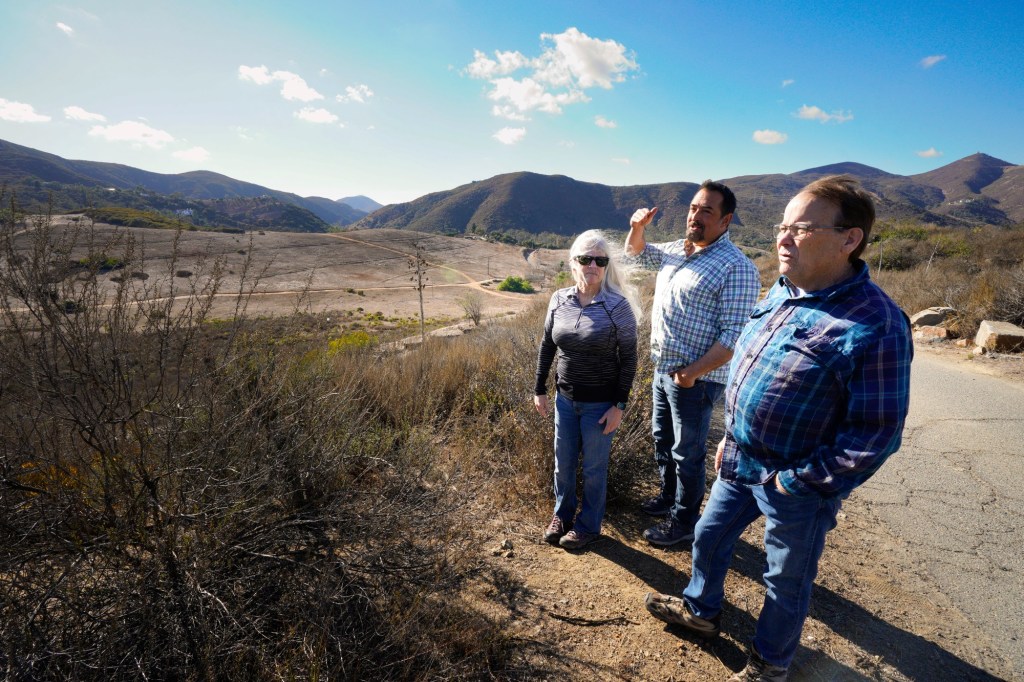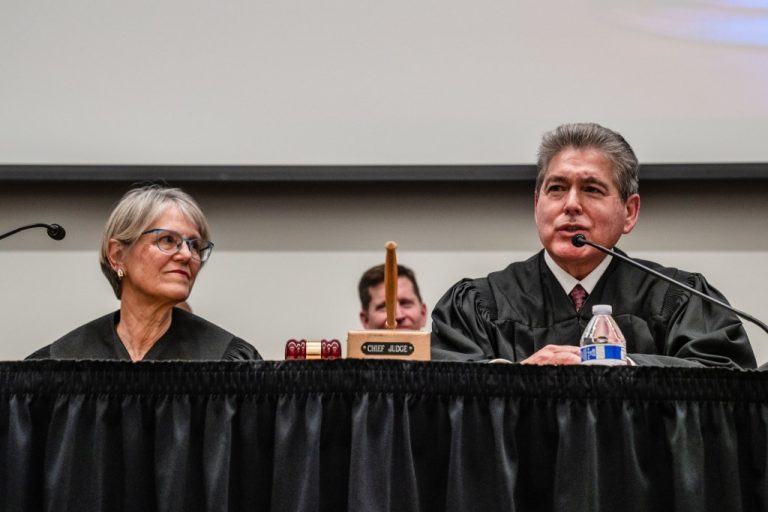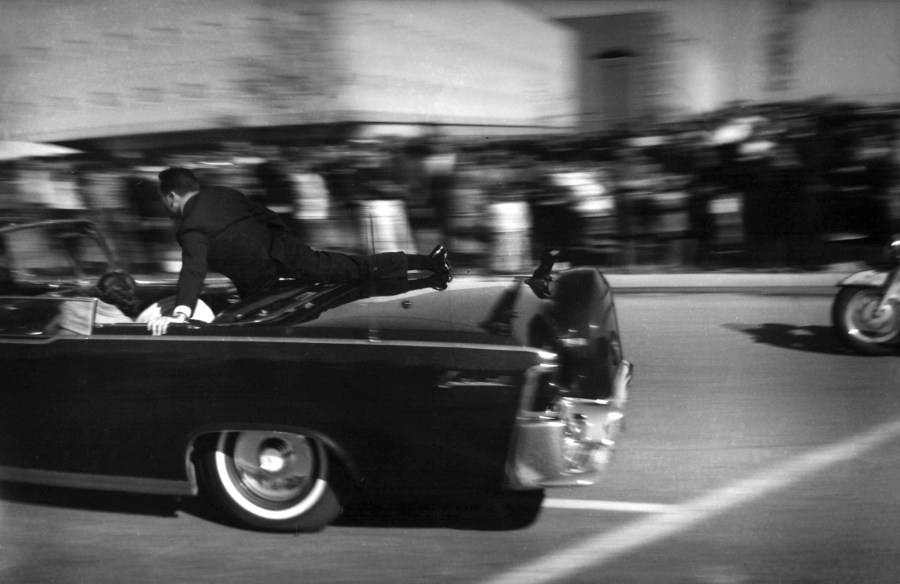
The images of the fires in Los Angeles stopped some Harmony Grove residents cold.
Debbie O’Neill knows the stress of evacuating as fire bears down. A decade ago, she and her husband fled after they saw the flames from the Cocos fire crest a nearby hill and hurtle down toward their Harmony Grove home. And that was before more than a 700-home development went up in the semi-rural area.
There’s the potential for 453 more residences in the area. O’Neill and neighbors are fighting it, arguing that they — and the new residents — will be vulnerable if there is a fire due to inadequate evacuation routes.
“We don’t want to die in here,” O’Neill said Tuesday. “And if we do, I want to make damn sure that everybody knows that the county Board of Supervisors knew that this was not a safe development.”
The battle may be personal for Harmony Grove residents — and this one has been going on for years — but the underlying concerns are a familiar hand-wringer for residents in a housing-hungry county with a history of deadly, destructive fires.
This is the second go-round for this project after a defeat a few years ago. It’s on track to go before the county planning commission for review later this year.

It’s likely the fight will be closely watched, as several other backcountry developments have failed to gain approval over fire danger in recent years.
In 2021, a judge halted the development of more than 1,100 homes in Otay Mesa, citing fire among the reasons. Earlier this year, the state bought the 1,300 acres for $60 million as part of a settlement to keep it as wildlands.
In 2022, a San Diego judge blocked the 3,000-home Fanita Ranch development in Santee, noting fire evacuation concerns. The judge blocked the project again last year.
And a development in Rancho Peñasquitos was able to move forward after a settlement last year that included adding a new fire evacuation route.
A big concern for residents in Harmony Grove: there is only one paved road in and out of the proposed development. They pointed to devastation from the recent Los Angeles fires — and noted images of cars abandoned when traffic clogged the streets and people were forced to flee on foot.
On Tuesday, O’Neill and several others fighting the development gathered on a ridge overlooking the vacant land where the homes could go up. They shared with reporters their concerns about evacuation.
“The problem with having one exit is that if that exit is blocked, everyone’s trapped,” said J.P. Theberge, vice chair of Elfin Forest Harmony Grove Town Council.
The developer is pushing back, issuing a statement that the company finds it “disappointing and, quite frankly, offensive that a small group of anti-housing activists here in San Diego are using this tragedy to advance their personal agenda in such an inappropriate and self-serving way.”
‘A catastrophe waiting to happen’
Harmony Grove sits south of state Route 78, in an unincorporated area between Escondido and San Marcos. The Harmony Grove Village South development would sit south of Escondido Creek and relies on two-lane Country Club Drive as the only way to cross the creek and reach larger thoroughfares. Country Club is the only paved road in or out.

The plan is to turn the two-lane crossing into a three-lane bridge over Escondido Creek.
The extra lane would function “as an equivalent form of egress by providing additional capacity for evacuation,” according to a 2018 staff report for the county planning commission.
A county spokesperson said last week that an analysis determined the site could be safely evacuated with the developer putting measures in place, including adding the third lane to the bridge.
The 2018 report notes that “potentially available alternatives for secondary access were evaluated and determined to be infeasible” for several reasons, the plan states, including topography, wildland fuels, environmental constraints, and the inability to secure ownership or access rights.
The plan mentions an “emergency only” route: the so-called Johnston Road Connection, noting it’s “not advised” because of the dirt road’s condition and exposure to fire fuels, but says it could be an “alternative access for emergency vehicles in the unforeseen scenario where other routes are considered unusable.”
The county spokesperson said the dirt road is not in the project’s fire protection plan.
Residents say one way out is not enough, and the dirt road is not particularly vehicle-friendly. Theberge said their experts have told them the housing project is “a catastrophe waiting to happen.”
“Think of a movie theater filled to the brim with only one exit and there’s a fire. Well, that’s what we’re facing here,” Theberge said.
The Sierra Club’s San Diego chapter is also watching the project, and its comments on the newest environmental impact report note it would bring more homes to an area with constrained evacuation but without adding new egress.
“Sierra Club is all over this issue,” said Peter Andersen, former chair of the local chapter. “You just can’t build projects in dangerous areas … but when you do build them in somewhat dangerous areas, you’ve got to provide for adequate evacuation.”
‘Fire safe’
Developer David Kovach, owner of RCS Harmony Partners LLC, said “a six-member independent team” was assembled to review the project’s fire protection plan as they prepared to again seek approval.
“This team, including Cal Fire, collectively represented 500 years of fire prevention, operational management and on-the-ground fire fighting experience of its members — real firefighters who have spent their careers saving lives, not ivory-tower PhDs pontificating from outside California,” he said. “This exceptional team concluded that Harmony Grove Village South is fire safe.”
The county first approved the plans in 2018, over the objections of residents. The Sierra Club and others sued.

In 2020, a San Diego judge ordered the county to rescind approval of the project and cited fire safety among her concerns. “There is no evidence that the mitigation measures, including adding an extra travel lane, will be effective in the event that the sole evacuation route is blocked by fire,” Superior Court Judge Katherine Bacal wrote.
In 2022, a state appellate court also told the county to rescind approval but cited greenhouse gases, not the fire plan, finding that the environmental impact report “adequately addressed fire safety and evacuation.”
Kovach noted that between the trial and appellate courts, “39 of the 40 claims made by project opponents were dismissed.” The only remaining issue, he said, concerns greenhouse gas mitigation. For that, he said, “We have developed a comprehensive and thoughtful mitigation plan.”
“It is also critically important to remember that San Diego is battling a housing crisis that impacts every corner of our County, and the only long-term solution is the creation of more homes,” Kovach said.
He said the project includes entry-level and middle-market homes close to jobs, services and open space.
“San Diego cannot tolerate any more delays caused by a small number of activists who create baseless diversions designed solely to discriminate against hard-working members of our community,” Kovach said.
A history of fires
Wildfires have burned in and around the area before. Among the more notable is the 1996 Harmony fire, which roared through Elfin Forest — a few miles west of the housing project site — then swept west into San Marcos, Carlsbad and Encinitas. Pushed by Santa Ana winds, the fire lasted three days and destroyed nearly 100 homes. A man whose car became disabled tried to run, but he was overcome by flames and died from his injuries several days later.

The following year, the Del Dios fire burned 1,200 acres and two homes.
Some of the opponents are survivors of the 2014 Cocos fire, which started on a windy afternoon in the hills behind Cal State San Marcos, burning through nearly 2,000 acres in San Marcos and Harmony Grove. Thousands fled. It destroyed about three dozen homes.
Aside from the fight against the housing project, people in that area are also trying to stop an unrelated proposal to put a containerized lithium-ion battery energy storage system in Eden Valley, just north of Harmony Grove between San Marcos and Escondido. If the Seguro Energy Storage Project is approved, the site’s 22.5-acre plot would generate electricity that would go to the state grid, providing enough to power about 240,000 homes for four hours. Among the residents’ concerns? The risk it might catch fire.
Originally Published:






